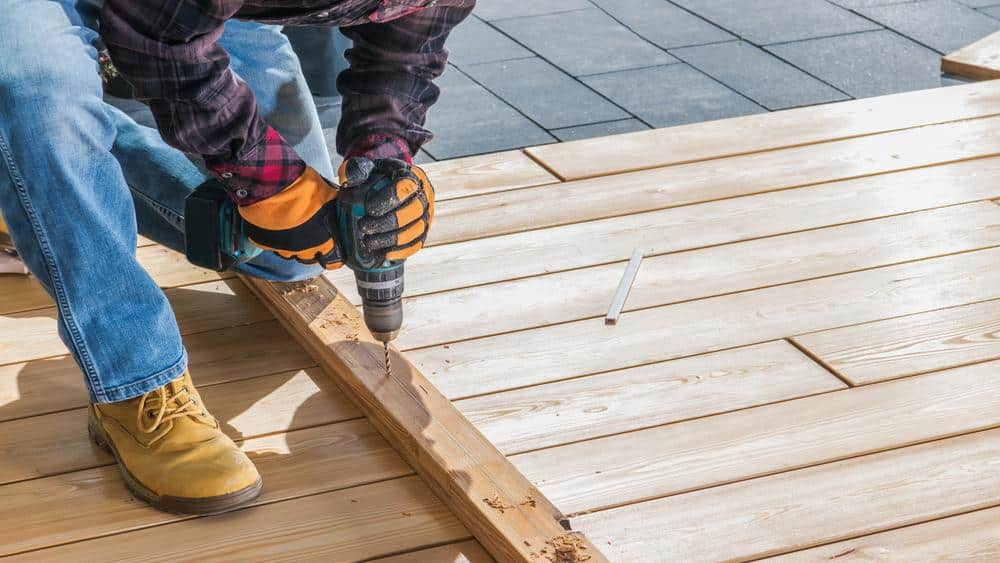We all need to know how to drill long straight holes in wood correctly. It is essential to understand how to drill straight holes to avoid mistakes when drilling.
Drilling with accurate holes is vital when making furniture. Knowing how to drill straight holes is essential to ensure you get the right angle when drilling.

Introduction: The Importance of Precision in Drilling Holes
Getting a hole just right can make or break your woodworking project. Whether you’re constructing furniture or simply hanging a frame, ensuring that your drill hole is straight is pivotal for structural integrity and aesthetic appeal. In this article, we’ll walk you through the step-by-step process of boring a perfectly straight hole through wood using a handheld drill.
Tools You’ll Need
- Handheld Drill
- Drill Bits (specific to wood)
- Carpenter’s Square
- Clamps
- Masking Tape
- Pencil
- Safety Glasses
Picking the Right Drill Bit
Choosing an appropriate drill bit is crucial for your project. The size, material, and design of the bit can influence how smoothly you can bore through wood. For hardwoods like oak or maple, consider a spiral-point bit, while softwoods like pine are best drilled with a brad-point bit.
If you’re wondering which drill bits can give you the best results for your woodworking projects, take advantage of our comprehensive guide on the Best Drill Bits For Woodworking: Reviews, Guide.
Preparing the Wood Surface
- Mark the Drill Point: Use a pencil to mark the exact point where you want the hole. Make sure the markings are visible but not too bold.
- Clamping the Wood: Secure the wood piece to a stable surface using clamps. This ensures that the wood doesn’t move while drilling.
- Safety Measures: Always wear safety glasses to protect your eyes from wood splinters.
Aligning the Drill for Accuracy
Hold the drill so that it’s perpendicular to the wood surface. To verify the alignment, place a carpenter’s square next to the drill bit, making sure the bit is parallel to the square’s edge.
The Drilling Process
- Initial Contact: Position the drill bit on the marked point and initiate slow rotation.
- Steady Pace: Maintain a consistent speed for a clean cut. Do not push too hard; let the drill do the work.
- Check Alignment: Periodically pause to confirm the drill is still aligned with your carpenter’s square.
- Through and Through: Continue drilling until the bit has completely passed through the wood.
Post-Drilling Tips
- Remove the Clamps: Carefully unclamp your workpiece from the table.
- Inspect the Hole: Make sure that the hole is as straight as you intended.
- Clean Up: Always clear away any wood debris or splinters from the work area.
How to Ensure the Straightest Hole: Expert Tips
- Lubricate the Bit: A little lubrication can go a long way in ensuring a smooth drilling process.
- Use a Drill Guide: For projects requiring ultimate precision, consider using a drill guide.
If you’ve found this guide helpful and are looking for more tips on achieving perfect holes in your woodworking projects, be sure to check out our other post: How to Drill Accurate Holes in Wood: Wood Drilling!.

Additional Advice for More Effective Drilling
Know Your Wood Type
Understanding the type of wood you’re working with can make a significant difference. Hardwoods like oak require different drill bits and techniques than softwoods like pine. Knowing the wood’s density can help you adjust the drill’s speed for optimal performance.
Pre-Drill with a Smaller Bit
If you’re drilling a particularly long hole, consider pre-drilling with a smaller bit. This serves as a guide hole and makes it easier to keep the larger bit straight when you drill the final hole.
Use a Stop Collar
For ensuring consistent hole depth across multiple pieces of wood, a stop collar is invaluable. This device fits onto your drill bit and stops the bit from going deeper once it hits the set depth.
Check the Drill’s Torque Setting
Most modern drills come with adjustable torque settings. For drilling long straight holes, use a medium torque setting to balance speed and control.
Keep the Drill Bit Clean
Resin and wood chips can accumulate on the drill bit, causing it to become dull or even get stuck. Periodically pulling the bit out and wiping it clean can prevent this.
Two-Handed Grip
Maintain better control over your drill by adopting a two-handed grip. This distributes the tool’s weight more evenly and allows for more precise alignment.
Use a Level
Some advanced drills come with built-in levels. If yours doesn’t, consider using a standalone level to ensure that your drill is perfectly vertical before you start and while you are drilling.
Drill in Intervals
Instead of drilling in one continuous motion, which can lead to overheating and reduced bit life, try drilling in intervals. Drill for a few seconds, pull out to remove the wood chips and then continue.
Use Cutting Oil for Lubrication
Cutting oil reduces friction between the wood and the drill bit, making the drilling process smoother and extending the life of your bit.
Test on Scrap Wood First
If you need to figure out how the drill or drill bit will behave, test them on a piece of scrap wood first. This gives you an opportunity to adjust your technique before working on the main project.
By adopting these additional tips, you can significantly improve the quality of your drilling work, ensuring long, straight holes that meet the requirements of your woodworking project.
Tricks to drill large Holes in wood
It can be challenging to search for how to drill long straight holes in wood. Thankfully, the following five tricks are excellent for drilling large holes in wood.
I. Portable drill press
For an accurate hole on any surface, just use your hand drill to turn it into a portable drill press. This drill attachment allows you to adjust the depth and angle for more accurate projects. You can simply toss it in your toolbox when you’re done.
II. For Straight Drill Hole Using CD Disk
Make it more creative: Trust me, I use this. It works well. Just place the old CD on the place where you want to drill them and right the site.
Begin by aligning your cd, then set it into place and start drilling. You can use a drill to get a clean hole in the wood, and the unused CD will get you there quickly.
If you’re feeling too exhausted, you can use different tools to make a square hole for your wooden project. You can use a hammer and a chisel or a drill that works for drilling a long straight hole.
III. Milescraft DrillBlock – Handheld Drill Guide
The Milescraft DrillBlock is a clever and convenient tool made specifically for these tasks. It costs only $8, and it helps you create perfect holes from 1/8 to 1/2 inches.
It’s an excellent value, and if you use a cordless drill more than a couple of times a year, it’s a no-brainer.
IV. The Reusable Jig
You can modify the DIY jig for more consistency when drilling many holes of the same size. Check the tube for an internal diameter that matches your drill bit from the hardware store or hobby shop’s brass and aluminum rod sections.
Don’t worry; this won’t be the number on the label, so take your drill bit or a pair of calipers with you to measure. Cut one 1/2-ish piece off the end.
V. 1 x 2 Scrap pieces of wood
This straightforward DIY project can seem intimidating at first but follow these simple steps, and you’ll be on your way to greatness in no time.
To start, choose two pieces of scrap wood that are 1 inch wide and two inches long. Next, use a hammer to gently but firmly tap the corner pieces together to form a right angle.
Hold it in place while doing this, so it doesn’t change. Now you’re ready to drill your hole. Start by making sure the drill bit is perfectly centered.
Drilling Long Straight Holes in Wood: The Problems and Their Solutions
Difficulty in maintaining straightness
Problem: Drilling lengthy straight holes in wood can be challenging because keeping a straight line demands a steady hand and a high degree of accuracy. Any variation from the straight line might result in an off-center or crooked hole.
Solution: To preserve straightness, a guide or jig should be used to keep the drill in a straight path. This can be as basic as using a piece of wood or metal as a guide, or as complex as utilizing a specialized drill jig.
Splintering and chipping of wood
Problem: When drilling long straight holes in wood, the wood has a propensity to splinter and chip at the edges, leaving unattractive markings and rendering the hole useless.
Solution: It is critical to use a sharp drill bit made for woodworking to avoid splintering and chipping. Using a slower drill speed and drilling in a straight line can also assist to reduce splintering and chipping.
Controlling drill speed is tough
Problem: When drilling long straight holes in wood, it can be hard to control the speed of the drill, resulting in the drill moving too slowly or too fast. This can cause the drill bit to overheat and shatter, as well as make the hole uneven or misaligned.
Solution: It is important to utilize a drill with customizable speed settings to manage drill speed. Furthermore, employing a drill press can help to keep the drill speed uniform and controllable.
Difficulty measuring the depth of the hole
Problem: When drilling long straight holes in wood, calculating the depth of the hole can be challenging, resulting in the hole being either too low or too deep.
Solution: It is crucial to utilize a depth gauge or stop collar that may be fitted to the drill bit to measure the depth of the hole.
Difficulty keeping the drill bit in position
Problem: When drilling long straight holes in wood, keeping the drill bit in place can be challenging, resulting in an uneven or crooked hole.
Solution: It is important to use a clamp or vise to hold the wood in place while drilling to maintain the drill bit in position. Furthermore, employing a customized jig that connects to the drill might assist in keeping the drill bit in position.
Difficulty in drilling through hardwood
Problem: Drilling into hardwood can be tough because it is denser and more difficult to drill through; it takes a long time and can cause the drill bit to wear out rapidly.
Solution: It is necessary to utilize a sharp, high-speed steel or cobalt drill bit optimized for drilling into hardwood while drilling. Drilling into hardwood may also be made simpler by utilizing a slower drill speed, drilling in a straight line, and adding a cutting fluid or lubricant.
Final Words
When it comes to How to drill long straight holes in wood, can be quite hard. But if you can focus and you can be patient, it’s not impossible. Somewhere in the world, there is a hole in a dowel.
After mastering the trick and successfully executing the trick, you won’t have to worry about any problems while creating straight holes. Until then, don’t give up, and keep on trying.







